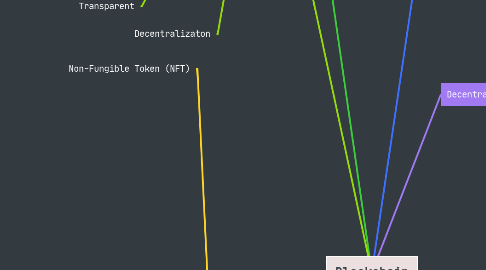
1. Blockchain layer
1.1. 0. Infrastructure
1.2. 1. Consensus
1.3. 2. Smart contract
1.4. 3. Applications
2. Properties
2.1. Scalability
2.1.1. Optimistic Rollups
2.1.2. ZK Rollups
2.1.3. Zero Knowledge (ZK) Proof
2.2. Security
2.2.1. Safe
2.2.2. Trust-less
2.2.3. Transparent
2.3. Decentralizaton
3. Digital tokens
3.1. Non-Fungible Token (NFT)
3.2. Currency tokens (Cryptocurrencies)
3.2.1. Bitcoin
3.2.1.1. Transaction
3.2.1.1.1. UTXO Model
3.2.1.1.2. Ledger: transaction-based
3.2.1.1.3. Merkel tree
3.2.1.2. Blocks
3.2.1.2.1. Timestamping
3.2.1.2.2. Mining
3.2.1.3. Vulnerabilities
3.2.1.3.1. Sybil attack
3.2.1.3.2. Selfish mining attack
3.2.2. Ethereum
3.2.2.1. Smart contract
3.2.2.1.1. Gas fees
3.2.2.1.2. Gas
3.2.2.1.3. Solidity language
3.2.2.2. Blocks
3.2.2.3. The Merge Event
3.2.3. NEAR
3.2.3.1. Layer 1
3.2.3.2. Open web wallet
3.2.3.3. Sharding
3.2.3.4. Nightshade
3.2.3.5. Rust language
3.2.4. Stablecoin
3.2.5. Wallet
3.3. Utility tokens
3.4. Commondity tokens
3.5. Security tokens
4. Types
4.1. Public
4.2. Private
4.3. Permissoned
4.4. Permissonless
5. Consensus Protocol
5.1. Proof of Work (PoW)
5.2. Proof of Stake (PoS)
5.3. GHOST Consensus Protocol
5.4. Proof of Elapsed Time (PoET)
5.5. Practical Byzantine Fault Tolerance (PBFT)
6. Decentrailized network
6.1. peer-to-peer systems
6.1.1. Unstructured P2P Networks
6.1.1.1. Napster: first P2P application
6.1.2. Structured P2P Networks
6.1.2.1. Graph Topology
6.1.2.1.1. Regular Graph
6.1.2.1.2. (Uniformly) Random Topology
6.1.2.1.3. Small-World Graph
6.1.2.1.4. Scale-Free Graph
6.1.2.2. Kademlia P2P
6.1.2.2.1. use in Ethereum
6.2. Decentralized applications (dApps)
6.2.1. Decentralized Finance (DeFi)
6.2.1.1. DEX
6.2.1.1.1. MakerDAO
6.2.1.1.2. Uniswap
6.2.1.1.3. KyberSwap
6.2.1.2. Equation of Exchange
6.2.1.3. Bonding Curve
6.2.1.4. Automated Market Maker (AMM)
6.2.2. Decentralized Game (GameFi)
6.2.3. Web3
6.3. Nodes
6.3.1. Store blocks data
7. Cryptography
7.1. Hash function
7.1.1. Properties
7.1.1.1. Puzzle-friendly
7.1.1.2. Collision-resistant
7.1.1.3. One-way function
7.1.2. Secure Hashing Function (SHA)
7.1.3. Eliptic curves
7.2. Public-Key cryptography
7.2.1. RSA algorithm
8. Application
8.1. Education
8.2. Governance
8.2.1. e-passport (Dubai)
8.2.2. Birth certificates (Illinois USA)
8.2.3. Land registry (Sweden)
8.2.4. Voting and election (West Virginia)
8.3. Businesses
8.3.1. Copy right violation (Microsoft)
8.3.2. Environment, foods (Wallmart)
8.3.3. Supply chain (Shell)
8.3.4. Financial (VISA)
8.3.5. Healthcare (IBM)
